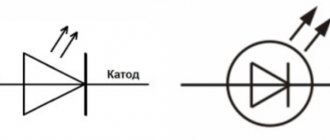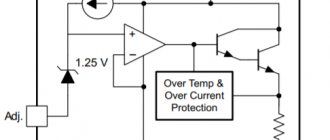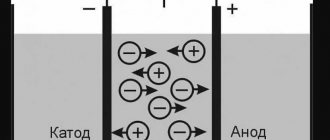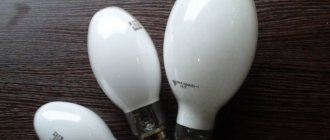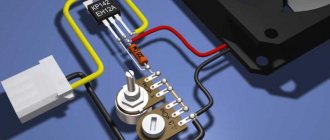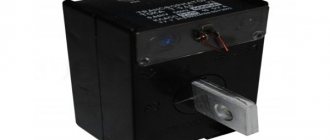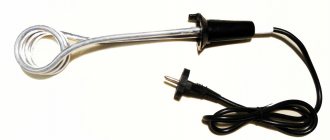Current parameters important for connecting a diode to a network
The operation of LEDs is based on three main parameters:
- supply voltage;
- consumption current;
- power dissipation.
The most important ones are LED voltage and current. It is easy to calculate the power value yourself by multiplying these two indicators. Knowledge of these parameters can be useful at any stage of work with elements - from replacing failed ones to selecting a power source. The basic characteristics of LEDs need to be considered more carefully:
LED current consumption
The current strength determines the stability of the element. An increase in this parameter, even within small limits, causes premature aging of the crystal (decrease in luminescence intensity) with a simultaneous increase in color temperature. To protect against excess current, drivers - stabilizers - are installed in LED lamps or lamps. Individual LEDs are connected to the network through resistors that provide the appropriate voltage and current drop. The value of these resistors must be calculated for each LED based on its characteristics.
Interesting! The current rating for most LEDs is 20 mA (0.002 A). There are designs consisting of 4 crystals, the consumption of which is 8 mA (4 crystals of 2 mA each). It is necessary to ensure that the true values correspond to the nominal values of the elements, otherwise failure will inevitably occur due to excess.
Voltage
“LED voltage” is not a completely correct expression. It is more correct to use the term “voltage drop”, which denotes the value at the output of the device when passing the rated current through the LED. Elements of different colors have their own operating voltage:
- for blue, white or green LEDs the voltage is 3 volts;
- red and yellow devices - from 1.8 to 2.4 V.
Using these indicators, you can approximately determine the LED voltage. However, it is impossible to say with certainty what the rated voltage is for a given element just by looking at its color and without performing any additional measurements. When the current parameters change, the shade of the glow changes, so it is not the nominal value that is visually determined, but the actual voltage.
Diode power
Power is the product of current and voltage. The indicator is calculated; outwardly it is practically impossible to determine. You can accurately find out the power of the LED from the data on the packaging; with a certain degree of error, the parameter is measured with a multimeter. A trained, experienced person is able to determine the value by the appearance of the element, but even here errors are possible, since many models are very similar to each other.
Why is it important to know these characteristics?
Knowing all the operating parameters of the LED will help to correctly replace the burnt out element. In addition, if you know the current consumption and voltage, you can calculate the power of the device, which is necessary when selecting the appropriate power supply.
LEDs that have low power ratings
The most common and frequently used type of LED is the so-called indicator, which has low power and small size. The size of these types of LEDs ranges from 3 to 20 millimeters. These elements can be found in a variety of household appliances. Almost all LEDs that are made in white have a current of 20 mA, 3.2 Volts, and a power of 0.06 W.
LEDs that have low power can include elements used for surface mounting and SMD type. They are designed to illuminate the TV screen, buttons, etc. to the required extent. This type of LEDs is often used for modern LED strips, which are widely used because they have high levels of practicality and efficiency in use. LED strips of two main types - SMD 3528 and SMD 5050 are made from the elements described above. Their power indicators are in the range of 1.2 - 2 W, which is quite enough to create high-quality and reliable LED strips.
How to determine LED parameters by appearance
Determining operating parameters or type by appearance is very difficult. It is rare to find people who are able to recognize this or that type of LED by its external features. Usually, due to their occupation, they constantly deal with them and begin to recognize the elements at first sight.
The ability to determine the type visually is significantly limited. You can try to check the type of element using photographs on the Internet. It’s not difficult to create a search query indicating the characteristics of an unknown LED, and then try to identify it by comparing it with similar devices in the pictures. The easiest way to decide on the type of device is when dealing with LED lamps.
Important! The type of diode is determined quite easily - by the shape of the case, the size and color of the lens, and other characteristic features. More detailed characteristics can only be obtained by measurements using a multimeter or similar devices.
LEDs that have high power ratings
This type of LEDs is used quite often and they can be divided into several specific types:
— Branded elements Nichia, Osram, CREE and others;
- Made in China.
If we compare LEDs that are produced by well-known companies and Chinese ones, then the former are made quite well, and also have high efficiency and reliability in use, but are expensive. The most commonly used elements, which are produced in China, have power ratings from 2 to 2.5 W. Chinese manufacturers produce elements that have an enlarged crystal. Remember that power consumption depends on current. For example, if you want to get a lamp that will have high efficiency indicators, then use elements capable of producing 110 lm per 1 W. For these types of LEDs, the current parameters should be in the range of 250-300 mA.
If heat removal is carried out correctly, then these LEDs will be able to work for a fairly long period of time. If for you, the most important indicator is the brightness of the lighting, then elements with a current above 500 mA are perfect for this. Many people are interested in how to measure the power of an LED; the efficiency and service life of this device depend on the indicators. To measure these values, you will need to assemble a relatively simple circuit, which we will consider next. Some types of these devices have an output power indicator, which makes them easier to use.
How to determine current parameters for an LED: methods, calculation examples
Determining the parameters of an unknown LED can be done in various ways, based on one or another technique. Some of them are purely mathematical, obtained through calculations based on the data obtained. Other options involve measuring the characteristics of LEDs using special instruments (testers or multimeters).
Why do you need to know the current?
Information about how much current a given LED consumes will allow you to avoid overloads or disruption of the operating mode when operating the lamps. A slight decrease in voltage helps to extend the service life, but exceeding the parameters sharply accelerates the failure of individual elements or the entire circuit.
If you are assembling a circuit from a large number of lamps, be sure to measure the current strength and compare the obtained value with the passport data. If the specified 20 mA is exceeded, it is necessary to increase the damping resistance (select resistors with a higher value). If the current in the circuit turns out to be slightly less (about 18 mA), then nothing needs to be corrected. This value will not significantly reduce the brightness of the glow, but will soften the operating mode and increase the service life of the lamps.
Methods for determining current, voltage and other parameters
Not everyone knows how to determine the current and other parameters of an unknown LED. There are different options that require certain knowledge and practical training, or simply the presence of a measuring device. The accuracy and correctness of testing the device depends on the methodology used. Users usually resort to the simplest and most accessible method for determining performance characteristics, although this may not be the most effective. The following options are known:
- measurement with special devices (multimeter);
- calculation of parameters using theoretical techniques;
- visual identification of LED type.
What is LED?
LEDs form an integral part in modern electronics, simple indicators for optical communication devices.
Light-emitting diodes use the properties of a pn junction and emit photons when current flows in the forward direction. LEDs specifically emit light when potentials are applied to the anode and cathode. The history of LEDs dates back to 1907, when Captain Henry Joseph observed the electro-luminescence characteristics of silicon carbide. The first LED was developed in 1962. It was developed by Holonyak, who worked for General Electric (GE). It was a GaAsP device. The first commercial version of LEDs came to market in the 1960s.
The manufacturing of LED technology boomed in the 1970s with the introduction of gallium aluminum arsenide (GaAlAs). These LEDs are high brightness and many times brighter than the old diffuse type. Blue and white LEDs were introduced in 1990, which use indium gallium nitride (InGaN) as a semiconductor. The white LED contains inorganic phosphorus. When the blue light inside the LED hits the phosphor, it emits white light.
Main conclusions
The ability to determine the operating characteristics of an LED allows you to create an optimal operating mode for it. As a result, the element will be able to demonstrate maximum service life and efficiency, and produce sufficient brightness without overload. Knowing the nominal parameters of the device will allow you to correct connection errors, select the most suitable type of power source, and avoid emergency situations or overloads. The ability to correctly determine the characteristics of an LED implies knowledge of various testing methods, from a simple determination of performance, to a more detailed test of operating current, voltage and power. This will expand the possibilities and allow you to use one of the options available in the given conditions.
Previous
LEDsHow to choose LED lights for the garage and organize lighting
Next
LEDsWhich is better: halogen or LED lamps for home and car
In LED strips
People are often interested in the question of how much does an LED strip consume? The power consumption of the tape depends on the type of LED chips used in it and the number of these chips per meter, which can vary from 30 to 240 pcs/m. Exact data on the power of the LED strip can be found on the manufacturer's page.
To determine how much a powerful LED consumes, you will have to assemble a simple laboratory bench from an regulated DC power supply, a resistor and a multimeter, and then take several measurements. There is nothing complicated about this, and the procedure for measuring the forward voltage and current of an LED is described in this article. At the end of the study, the obtained parameters are multiplied and the real power value is found out using the formula P=U*I.
Characteristics of 1 W and 3 W LEDs
I took LEDs from a local store (origin unknown) and a diode purchased on Aliexpress. According to the sellers, both are 3 W.
Let's look at the characteristics of 1 and 3 W LEDs. Let's take the most popular ones from Epistar. LEDs from other manufacturers, in principle, do not differ from these data.
Characteristics of 3 W and 1 W LEDs
1 of 2
Characteristics of 1 W LED
Characteristics of 3W LED
How to read the performance characteristics of LED light sources - see the article.
We see that the operating current of 1 W diode is 350 mA, 3 W - 700 mA. The maximum peak current for both is 0.8 A. That is. both of these diodes will operate at the maximum possible 0.75A. They will work at 1 A, but not for long). You shouldn't overclock chips unnecessarily; we still care about durability. Moreover, if you purchased the right LED, then the brightness will be enough for you.
Advantages and disadvantages
More and more users are seeking to replace outdated incandescent lamps with modern models of LED lamps. The main advantages of using LEDs:
- saving energy without compromising the luminous flux of the lamp;
- durable materials of the body and internal elements: low probability of mechanical damage;
- long service life: several times higher than that of Ilyich bulbs;
- size: diodes are compact and quite mobile;
- high brightness;
- safety: minimum network voltage – 3-24V.
Disadvantages include high cost and the need for constant voltage. The price of products is gradually decreasing due to high consumer demand.
Reference table of parameters of popular SMD LEDs with datasheets
Using the reference data from the table below with the technical characteristics of the most popular SMD LEDs, you can calculate and evaluate their lighting capabilities when making backlights and luminaires yourself, or by purchasing ready-made light sources. Using the data from the table, you can determine the parameters of the LED strip if there is no marking on it.
By clicking on the blue inscription indicating the type of LED, you can view the datasheet from the manufacturer, which is stored directly on the website. The datasheets provide more detailed technical characteristics of ordinary and ultra-bright LEDs, taking into account the amount of current flowing through them and the ambient temperature.
| Reference table of the main technical characteristics and standard sizes of the most popular brands of SMD LEDs used for lighting with datasheets from manufacturers | |||||||
| Appearance | LED type | Glow color | Size, mm | Luminous flux, lm | Angle, degrees | Current, mA | Voltage, V |
| LED-508H184WC-HD | white | ∅5,0 | 0,5 | 15 | 20 | 2,8-3,6 | |
| LED-508H238WC-HD | |||||||
| LED-508H256WC-HD | |||||||
| LED-HK5H4ULC-WW | white warm | ∅5,9 | 2,5-10,4 | 160 | 20 | 2,1-3,4 | |
| LED-HK5H4ULC-W | white | 2,5-10,4 | |||||
| LED-HK5H4UBC | blue | 3,1-4,4 | |||||
| LED-HK5H4UGC | green | 2,6-10,4 | |||||
| LED-HK5H4URC | red | 3,1-4,4 | |||||
| LED-HK5H4UYC | yellow | 3,1-4,4 | |||||
| LED-HK5H4UOC | orange | 3,1-4,4 | |||||
| Super bright | LED-WW-SMD2835 | white warm | 2,8×3,5 | 50 | 120 | 150 | 2,9-3,3 |
| LED-NW-SMD2835 | neutral white | 55 | |||||
| LED-PW-SMD2835 | pure white | 60 | |||||
| LED-CW-SMD2835 | cold white | 60 | |||||
| Super bright | LED-WW-SMD3014 | white warm | 3,0×1,4 | 11,5 | 120 | 30 | 2,1-3,4 |
| LED-NW-SMD3014 | white | 11,5 | |||||
| LED-CW-SMD3014 | cold white | 12,0 | |||||
| LED-B-SMD3014 | blue | 0,85 | |||||
| LED-G-SMD3014 | green | 2,5 | |||||
| LED-Y-SMD3014 | yellow | 1,88 | |||||
| LED-R-SMD3014 | red | 2,45 | |||||
| LED-O-SMD3014 | orange | 0,66 | |||||
| LED-WW-SMD3020 | white warm | 3,0×2,0 | 5,0 | 120 | 20 | 2,1-3,4 | |
| LED-NW-SMD3020 | white | 5,5 | |||||
| LED-CW-SMD3020 | cold white | 5,5 | |||||
| LED-B-SMD3020 | blue | 0,87 | |||||
| LED-G-SMD3020 | green | 3,1 | |||||
| LED-Y-SMD3020 | yellow | 0,7-2,2 | |||||
| LED-R-SMD3020 | red | 0,85 | |||||
| LED-O-SMD3020 | orange | 0,5 | |||||
| LED-WW-SMD3528 | white warm | 3,5×2,8 | 4,5-5,0 | 120-140 | 20 | 2,8-3,2 | |
| LED-CW-SMD3528 | white | 4,5-5,0 | 2,8-3,2 | ||||
| LED-B-SMD3528 | blue | 0,6-0,85 | 2,8-3,2 | ||||
| LED-G-SMD3528 | green | 2,8-3,5 | 2,8-3,2 | ||||
| LED-Y-SMD3528 | yellow | 1,2-1,6 | 1,8-2,0 | ||||
| LED-R-SMD3528 | red | 1,2-1,6 | 1,8-2,0 | ||||
| LED-RGB-SMD3528 | RGB | 3,5×2,8 | 0,6 | 120-140 | 20 | 2,0-2,8 | |
| 1,6 | 20 | 3,2-4,0 | |||||
| 0,3 | 20 | 3,2-4,0 | |||||
| LED-WW-SMD4008UWC Side glow | white | 4,0×0,8 | 5 | 120 | 20 | 3,0-3,6 | |
| LED-WW-SMD4014 | white warm | 4,0×1,4 | 22 | 120 | 60 | 2,8-3,4 | |
| LED-PW-SMD4014 | white | 23 | |||||
| LED-CW-SMD4014 | cold white | 23 | |||||
| LED-SMD4020 | white | 4,0×2,0 | 72 | 120-140 | 150 | 6,0 | |
| LED-WW-SMD4530-1 | white warm | 4,5×3,0 | 70 | 120-140 | 600 | 2,9-3,8 | |
| LED-WW-SMD5050 | white warm | 5,0×5,0 | 10,0-12,0 | 120-140 | 3×20 | 3,2-3,4 | |
| LED-W-SMD5050 | white | 11,0-14,0 | 3,2-3,4 | ||||
| LED-B-SMD5050 | blue | 2,0-2,5 | 3,1-3,6 | ||||
| LED-G-SMD5050 | green | 8,0-8,5 | 3,1-3,5 | ||||
| LED-Y-SMD5050 | yellow | 4,5-5,0 | 1,9-2,2 | ||||
| LED-R-SMD5050 | red | 4,5-5,0 | 1,8-2,2 | ||||
| LED-RGB-SMD5050 | RGB | 5,0×5,0 | 1,6 | 120-140 | 20 | 1,6-2,0 | |
| 2,5 | 20 | 2,8-3,2 | |||||
| 0,6 | 20 | 2,8-3,2 | |||||
| LED-WS2812S with PWM controller WS2811 | RGB | 5,0×5,0 | 2,5 | 120-140 | 20 | 1,8-2,2 | |
| 5,4 | 20 | 3,0-3,2 | |||||
| 1,2 | 20 | 3,2-3,4 | |||||
| LED-WS2812B with PWM controller WS2811 | RGB | 5,0×5,0 | 2,5 | 120-140 | 20 | 1,8-2,2 | |
| 5,4 | 20 | 3,0-3,2 | |||||
| 1,2 | 20 | 3,2-3,4 | |||||
| LED-SMD5630-05 | white | 5,6×3,0 | 40 | 120 | 150 | 3,3 | |
| LED-SMD5730-05 | white | 5,7×3,0 | 45 | 120 | 180 | 3,1-3,3 | |
| LED-SMD5730-1 | 110 | 350 | |||||
| LED3500Am1W-A120 | white warm | ∅8,0 | 40-60 | 120-140 | 350 | 3,2-4,0 | |
| LED6000Am1W-A120 | white | 75-85 | 3,0-4,0 | ||||
| LED470Am1W-A120 | blue | 15-20 | 3,2-4,0 | ||||
| LED515Am1W-A120 | green | 40-50 | 3,2-4,0 | ||||
| LED625Am1W-A120 | red | 30-40 | 2,0-2,8 | ||||
| LED Luminus SST-50 | white | boards ∅21 | 100 | 125 | 1750 | 3,2 | |
| LED Luminus SST-90 | white | boards 10×11 | 1300 | 120 | 3150 | 3,25 | |
| LED Luminus CSM-360 Consists of 4 SST-90 | white | boards 36×36 | 2100 | 115 | 3150 | 13,14 | |
| LED Cree-XHP50 Consists of 4 led | white | 5×5 | 2546 | 120 | 3000 | 6 | |
| 1500 | 12 | ||||||
| LED Cree-XHP70 Consists of 4 led | white | 7×7 | 4022 | 120 | 4800 | 6 | |
| 2400 | 12 | ||||||
